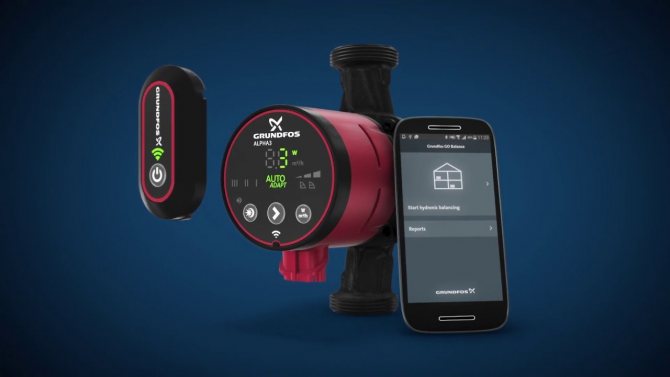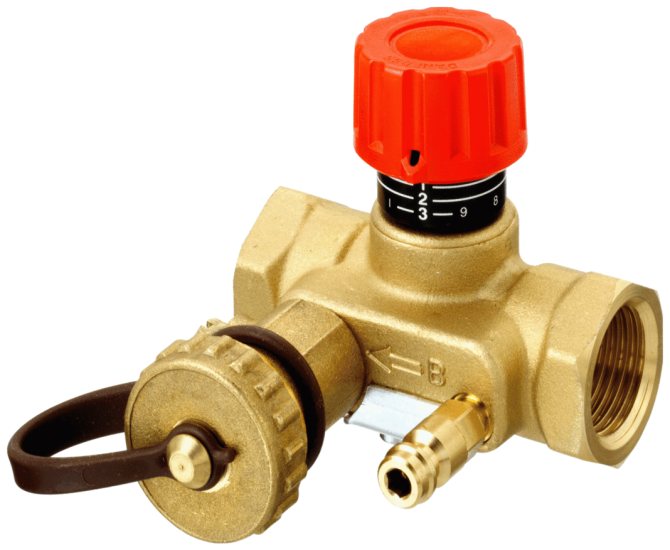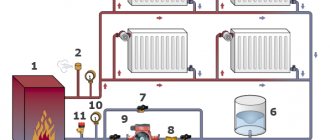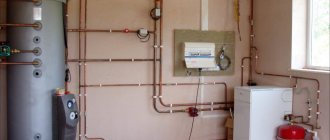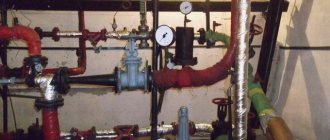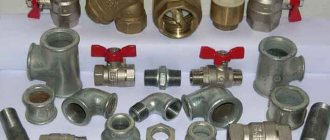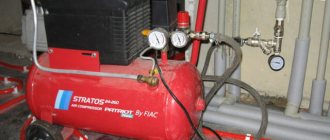What is the essence of balancing
Hydraulic heating systems are rightfully considered the most complex. Their effective work is possible only with a deep understanding of physical processes hidden from visual observation. The joint operation of all devices must ensure that the heat carrier absorbs the maximum amount of heat and distributes it evenly over all heating devices of each circuit.
The operating mode of each hydraulic system is based on the relationship of two inversely proportional quantities: hydraulic resistance and throughput. It is they who determine the flow rate of the coolant in each node and part of the system, and therefore the amount of thermal energy supplied to the radiators. In the general case, the calculation of the flow rate for each individual radiator reflects a high degree of unevenness: the farther the heating device is from the heating unit, the higher the influence of the hydrodynamic resistance of pipes and branches, respectively, the coolant circulates at a lower speed.
The task of balancing the heating system is to ensure that the flow in each part of the system will have approximately the same intensity even with temporary changes in operating modes. Careful balancing makes it possible to achieve a state where individual adjustment of the thermostatic heads does not significantly affect other elements of the system. At the same time, the very possibility of balancing should be provided even at the design and installation stage, because to configure the system, both special fittings and technical data for the boiler room equipment are required. In particular, it is mandatory to install shut-off valves on each radiator, in the common people called chokes.
Why do you need hydraulic balancing?
Regardless of the type of installed heating system, it must deliver the amount of coolant calculated by the designer, which in turn must heat the radiator to the required temperature. At the same time, as much working fluid must pass through each of the heat exchangers as indicated in the developed project for the heat supply of the house. According to the laws of hydrodynamics, a larger amount of the working medium will follow the path of minimum resistance, that is, to the heat exchanger closest to the heating unit.
Differences in the temperature and amount of hot water flowing through the heat exchanger will lead not only to differences in the temperature regime of different rooms, but also to an increase in the load on the heating boiler.
When do you need to hydraulically balance?
Hydraulic balancing of the heating system should be used in the following cases:
- Radiators located close to the heating device are noticeably hotter than the "last" ones in the hydraulic system for heating the premises, which is noticeable both by touch and by the readings of a room thermometer or personal feelings.
- During the heating season, one or several heat exchangers make noise in the form of the murmur of the working fluid flowing in it.
- The underfloor heating pipes located in the concrete screed heat up unevenly.
- When setting up a heating system, which is assembled without a project developed by a heating engineer and the services of professional installers.
But if the heating system functions flawlessly, then you should not try to improve its work on your own, since due to inexperience, homeowners achieve exactly the opposite result. Also, you should not start balancing the heating system if any problems have arisen in it (rupture of the membrane in the expansion tank, clogging of the balancing or radiator shutoff valves, airiness of the batteries, the appearance of leaks, and so on). At the beginning, you need to fix the problem and, most likely, the need for adjustment will disappear.
Symptoms of problems
It should be said right away that it is not necessary to climb to the valves just out of love for art. Many technical specialists have a favorite phrase: "It works - don't touch it." Here it is also quite possible to apply it. If you do not notice any negative signs in the operation of the heating system, then let it operate in the current mode. If you turn the taps at random, you can, on the contrary, unbalance everything, and then you will have to fix it.
Let's look at the phenomena that are clear signs of a lack of balancing:
- temperature difference in rooms. As mentioned above, with poor-quality balancing or its complete absence, some rooms will be much colder than others. The rooms closest to the boiler will torment you with a suffocating heat, and in the farthest rooms you will freeze;
- one of the radiators is constantly gurgling. Such noise indicates a malfunction in the coolant flow;
- a warm floor, poured with a concrete screed, unevenly heats the surface.
If you have just installed a new heating system, then a priori it needs balancing, regardless of the presence of any signs.
It should be noted that not every problem in the operation of a heating system is related to its balancing. On the contrary, there are times when it is absolutely pointless to carry out this operation:
- airiness of the system;
- leakage;
- blockage formation;
- malfunction of the expansion tank.
All these factors can lead to uneven heating of the premises. Balancing won't help here. It is necessary to eliminate the reason why the system is malfunctioning. For example, to deal with airiness, use Mayevsky taps, which are usually installed on radiators. With their help, you can easily and quickly expel air from the place where it is not supposed to be. As soon as you cope with the airlock, the coolant current will immediately recover. You can learn more about how to use the Mayevsky crane from the articles on our website.
As for other reasons, everything is obvious. The leak must be repaired (or the damaged element must be replaced with a new one), the blockage must be eliminated, the expansion tank must be repaired (as a rule, the problem is a diaphragm rupture). Only after that, if problems with the distribution of the coolant still persist, balancing can be carried out.
If you live in an apartment building, then the question of how to balance the system is not worth it. On the contrary, you cannot climb there with your own hands, since any wrong actions will negatively affect not only your apartment, but also the neighbors. If you notice problems with heating in such a dwelling, then contact the management company - the solution of such situations is exclusively in their competence.
As for a private house with an autonomous heating system, some owners believe that it is possible to simply regulate the flow of coolant in radiators using conventional shut-off ball valves. In fact, this is not the case.
That is, if you open such a tap only by half, then the volume of the incoming liquid, of course, will decrease, thereby changing the temperature in the room. But with the locking equipment, problems will soon arise.The ball valve is not designed for such manipulations, its life principles are simple: it needs to be either completely open or completely closed. Any half-measures worsen its performance, and then completely disable it.
Therefore, balancing must be carried out, as they say, wisely. And now we will tell you in detail how to do this.
the main objective
No matter how we tried to make the heating circuit correctly, it often turns out that the last battery heats up not only longer, but also not enough.
In this case, there is no reason to increase the power of either the system or the pump, since this is not the problem.
- Balancing helps to distribute the heat energy coming from the heat generator through the pipelines, depending on the needs of each room.
- Provides assistance to do this procedure, first of all, shut-off and control valves... It is a responsible heating component, which allows you to increase or decrease the flow of the coolant to a certain section of the heating system.
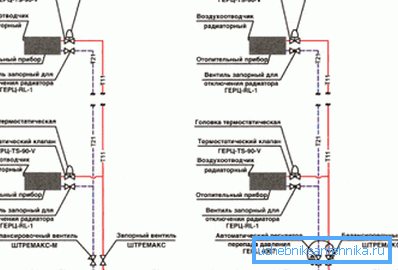
Advice: installing automatic temperature control equipment does not preclude balancing the batteries.
- In this case, they are only an additional tool that allows you to maintain the desired comfort in the premises.
- Setting up heating equipment and radiators is a paramount necessity... Based on this, we recommend that you first perform balancing and only later install automatic systems, if you wish.
Advice: keep in mind that basically the latter have a centralized character, being responsible not for adjusting the flow of the coolant, but for its temperature in the heating device.
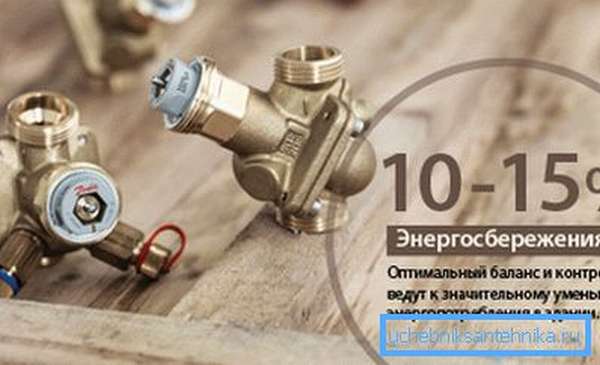

What does that require
Balancing is done through the following components:
- flow regulators,
- bypass valves,
- balancing valves,
- pressure regulators.
We recommend that you take products only from time-tested manufacturers, in addition, at a time when their price is slightly higher than the rest.
The installation of certain elements is based on the design of the heating system:
- in a one-pipe circuit, the instruction recommends only installing manual taps, which will help to vary the intensity of the heated water supply to any room,
- in two-pipe systems, especially where the temperature is controlled by automatic devices, balancing valves cannot be dispensed with.
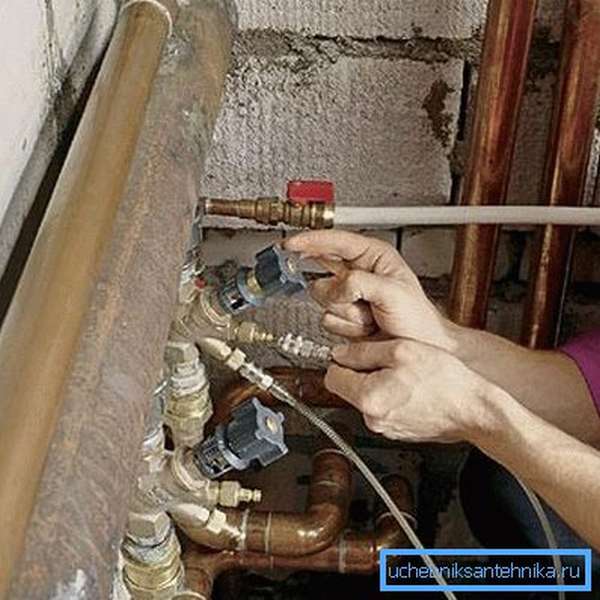

Methods
There are a couple of ways to perform the procedure. Let's consider their essence with an example:
| Uncomplicated | The most time consuming option, at a time when it is sometimes directed to measure the readings of each balancing valve during the correction of their positions. The goal is to adjust the valve positions in such a way that the result will satisfy you. |
| Complicated | It is considered more reliable because the system is split into separate modules. In this case, its non-specialized power is taken as 100%, and the data that comes from individual modules is converted into appropriate fractions, for example, 50 or 20%. Later, each module is adjusted separately, obtaining the flow rate of the coolant to the desired percentage of the total heating system power. For example, for a bedroom you chose 20%, but this indicator turned out to be not enough to reach a comfortable temperature. Based on this, you decide to expand the intensity by another 10%, for which you just unscrew the module valve a little. |
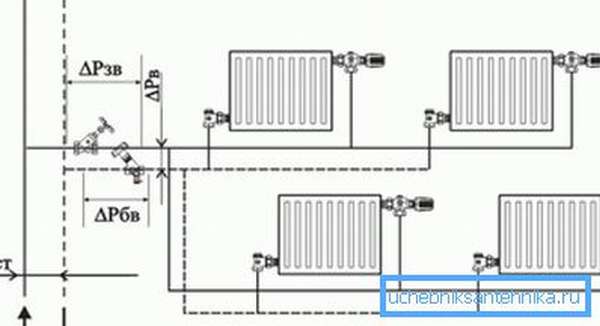

Advice: before starting balancing work on the heating system, open any shut-off valve and make a test run. You must ensure that the heating circulation pump, other components and batteries in the circuit are working properly.
Work with radial distribution and underfloor heating
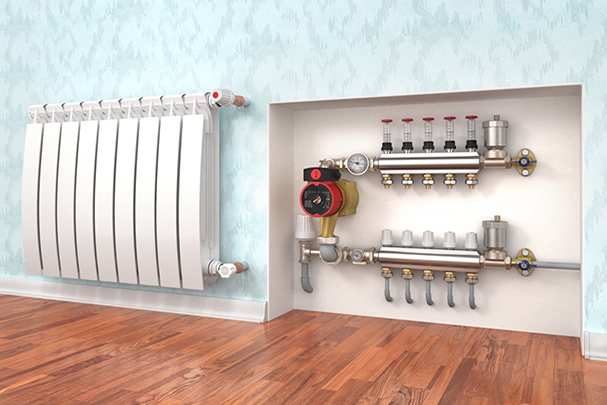

As mentioned above, a slightly different procedure is used for manifold wiring. It is suitable for both radiators and underfloor heating - in general, for balancing an entire system connected to one node.
The setting can be done in two different ways. For the first of these, rotameters must be on the manifold. These elements are transparent flasks and are flow meters. To balance, you need to do some calculations. In doing so, the following formula is used:
The letter G in this case denotes the mass flow rate of the heated coolant that flows along the circuit. The unit of measurement is kg / h. The letter Q denotes the amount of heat energy that must be emitted by the heating circuit, it is measured in watts. As for Δt, this is the difference in temperatures obtained at the entrance to the loop of the loop and at the exit from it. The calculated value for this parameter is 10 degrees.
Thus, you can calculate how many liters of heated coolant must pass through a certain section of the circuit per minute. The required amount of heat generated can be calculated using standard values. According to them, 100 watts are needed for every square meter of area.
Let's give an example of calculation. Let's say your room area is 20 m 2. This means that it needs 2 kW of thermal energy to heat it. Substituting the resulting value into the formula above, and we get the following result:
On flow meters, the values are indicated in l / min, so it is necessary to convert the value by dividing the result by 60. It turns out about 2.87 l / min.
After making calculations, the balancing procedure is carried out as follows.
- Fill and pressurize the heating circuit. The heating boiler does not need to be switched on. But the circulation pump must be started.
- Close the thermostatic valves on the second part of the collector; this is done manually using special caps.
- Now open the first valve. Adjust the rotameter that corresponds to it using the lower ring - it needs to be rotated. Thus, set a certain level of flow rate of the heating medium.
- After you deal with the first group of valve + flow meter, close this valve and go to the second pair.
- Thus, adjust each flowmeter in turn. Finally, open all of them and check if each device correctly shows the flow rate of the coolant.
If there are no rotameters, then the process is carried out according to the results of measuring the temperature in the loop loops. The procedure in this case will be rather dreary and long.
If you need to balance not a warm floor, but radiators connected using radial wiring, then everything is done in the same way. For greater confidence, you can focus on both manifold rotameters and temperature measurements. We are sure that after reading today's article, you will not have any problems with balancing. Good luck!
In accordance with current legislation, the Administration disclaims any representations and warranties, the provision of which may otherwise be implied, and disclaims liability in relation to the Site, the Content and its use. More details: https://seberemont.ru/info/otkaz.html
Was this article helpful?
Tell your friends
Work with one-pipe and two-pipe system
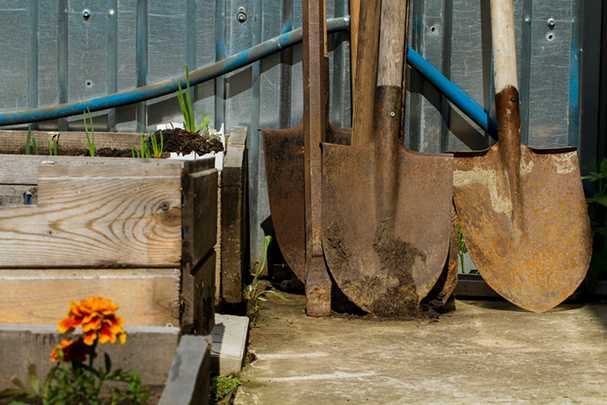

It should be said right away that the balancing procedure differs depending on which system you are working with. For one-pipe and two-pipe procedures one, for collector and underfloor heating - another. Let's start with the first one.
The essence of the procedure is simple. You must first measure the current temperature of all radiators.If a critical difference in performance is detected, harmony is achieved by adjusting the flow using special balancing valves located at the entrance to the battery. The step-by-step procedure is as follows.
- After the boiler has heated the coolant to the maximum possible temperature, open all the valves responsible for adjusting the current.
- measure the temperature of the liquid leaving the boiler. To do this, it is necessary to attach an electronic contact thermometer to the branch pipe with the help of which the pipe leading to the radiators and other heating devices is connected to the water heater.
- Go to the radiator closest to the boiler room. In turn, attach the thermometer to the pipes through which the coolant flows in and out. Ideally, the temperature difference should be no more than 10 degrees between the inflow and outflow. If this indicator is normal, then there are no problems with this radiator.
- Check each radiator in the same way as described in the third point. Be sure to write down the observation results.
- Now compare the readings obtained on the inlet pipe of the first and last batteries in the circuit. If the difference is within two degrees, then for the first pair of radiators, close the balancing valves by half a turn or a full turn. Then take measurements again.
- When you achieve a difference of three to seven degrees between the first and the last battery in this way, close the valves of the first two radiators again, now by 50–70 percent. For heaters located in the middle of the circuit, perform the same procedure, but for 30-40 percent. Do not touch the radiators that end the system.
- After all these procedures, wait half an hour. During this time, the radiators will warm up already taking into account the innovations. Measure again. If the difference between the first and the last radiator is 2-3 degrees, then everything is fine. If not, then repeat the setting of each heater again. The valves should be closed a little at a quarter or half turn. When you achieve the same temperature in all heated batteries, the procedure will be completed.
This procedure is perfect for balancing a two-pipe closed heating system. Of course, the number of turns of the valves during adjustment can vary - it all depends on your particular home. Therefore, do not turn them too much at once, it is better to do everything gradually. With patience and regular measurements, you can achieve the perfect result.
As for a one-pipe system, to the circuit of which no more than four radiators are usually connected, then it does not need such a meticulous approach. As a rule, its adjustment is made by slightly blocking the flow of the coolant into the battery, which is located closest to the heating boiler.
Why do they carry out hydraulic adjustment of CO
The main goal of balancing the heating system is the correct distribution of the amount of coolant to the radiators (batteries) per unit of time, directing the required amount of heat to places where there is a shortage of it.
For a more complete understanding of the picture, let's imagine that at a certain section of the CO, it is divided into two circuits, each of which leads to different rooms. Since the volume of the premises is different, the length of the contour may also differ. A circuit with a longer length (or more heaters) has a higher flow resistance. As you know, water (coolant) always follows the path of least resistance. In other words, according to physical laws, more heat will enter a circuit with a shorter length than distant radiators. The figure clearly shows the distribution of heat energy in two identical systems.
It should not be forgotten that in a non-tuned CO, the heat generator operates at maximum, which negatively affects all structural elements.
Summarizing the above, CO balancing is carried out for:
- Uniform heating of batteries, regardless of their location in the heating system.
- Economical operation of the boiler plant.
Advice! Balancing a two-pipe heating system (made with preliminary hydraulic calculations), short length (no more than 4 heaters) - optional
.
In all other cases, hydraulic adjustment is necessary for efficient and economical CO operation!
Special equipment
Y-valves are so named because they have a special body configuration. After inserting into the system, it is located at an optimal angle to the line. This minimizes the effect of fluid flow on the valve and improves balancing accuracy. The structural elements of such a valve are:
- control knob;
- external stem seal;
- brass drain cock;
- setting memory device;
- measuring nipple, etc.
Such equipment for balancing a two-pipe heating system maintains a constant pressure difference between supply and return. In one-pipe communications, valves of this type "monitor" the constant flow rate of the coolant. There are also universal models that can be installed in any network.
To measure the temperature of the radiators when using the second balancing technology of the home heating system, a special contact thermometer should be used. Without such equipment, the setup procedure in this case may be ineffective. Of course, it will not work to precisely equalize the temperature of the radiators tactilely. A contact thermometer is very inexpensive and very easy to use. Such a device is simply applied to surfaces, and it immediately determines the temperature of its heating.
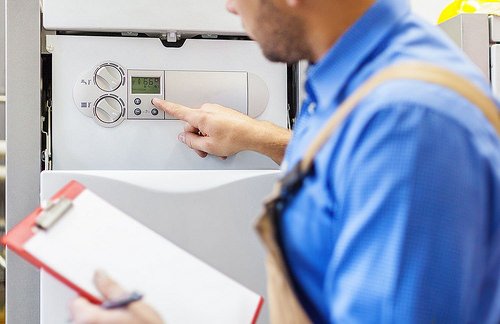

Balancing the heating system in a private house
After completion of the installation, it is necessary to adjust the heating system or balance it. This allows you to identify, fix, eliminate discrepancies in the operation of the boiler unit and other devices, ensuring high efficiency of work and heat transfer.
Contrary to popular belief, the heating system of not only a large multi-storey building, but also a small private house, up to a small-sized country house, needs balancing. Imbalance is the cause of improper heat distribution, when it is very hot in some rooms and not warm enough in others.
Therefore, it is recommended to carry out balancing before the beginning of each heating season.
Heating system pressure testing
If you want the heating system to work smoothly and without any problems, it needs to be well designed and installed. But as it turns out, this is not enough. The equipment must be put into operation.
And for this, nothing more is done than pressure testing - hydraulic tests, pressure testing of the OKPD heating system - the necessary tests that must be carried out not only when installing the system, but also when replacing or repairing a heater and in preparation for the next heating season.
Such a tightness test will reveal all violations and the need for such work is obvious. Crimping used to take more time and effort, now it is much easier. The work is carried out using special equipment.
Next, we start crimping. It includes a number of activities. We carry out preventive maintenance of the system and its preparation. It is necessary to create pressure inside the system, it is necessary for the work. The final step is to flush the entire heating system.
If the system has passed all the tests, then it is ready for use.
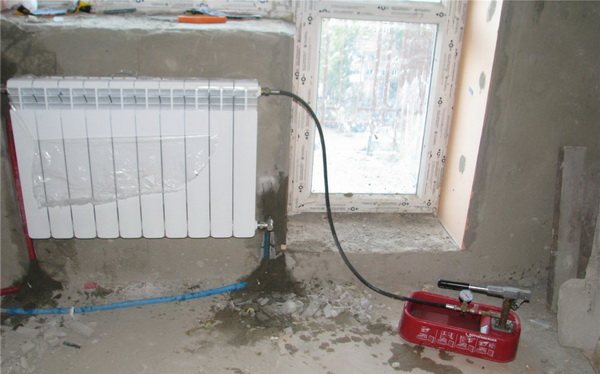

More on this topic on our website:
- What are the heating systems of an apartment building - schemes Heating systems of most multi-storey buildings in our country, as a rule, are connected to a CHP or a central boiler house, that is, they are centralized. Depending on how ...
- Currently, in suburban housing construction, various types of heating devices are used. When choosing them, a number of determining factors are involved, in which, along with efficiency and availability, ...
- Trouble-free operation of heating systems in any home is one of the main components of comfortable living in it when the cold weather sets in. Even assembled in compliance with all ...
- Comfortable living in a private house is impossible without a properly selected and well-installed heating system. Only a well-thought-out and optimized look of the system can create in the house ...
Balancing tools
These include a balancing valve and a special measuring device.
The balancing valve is a type of shut-off valves for adjusting the hydraulic resistance in heating systems. The device solves the problem by changing the diameter of the pipe section.
Modern Y-type models are presettable, which limits the flow marked on the scale knob. The design provides for the presence of two nipples for measuring pressure, temperature, and differential flow rate of the coolant. The name is due to the shape of the body, where the cones are placed at an optimal angle to each other. This minimizes the influence of the coolant flow on the measurements, increases the accuracy of the adjustment.
When to install
:
- The maximum load on the system does not provide a comfortable temperature.
- Under constant load, significant temperature differences are observed in the room.
- Normal heating power cannot be achieved.
The advantages of installing this device are as follows
:
- Reduced fuel consumption and heating costs.
- Increasing the efficiency of using the heating system and increasing comfort due to the ability to regulate the air temperature in each individual room.
- Simplifies startup.


Modern balancing crane
Balancing valve installation involves the use of special fittings and adapters
It is important to pay attention to the presence of an arrow stamped on the body of the device and its direction. Some devices are mounted strictly in a certain direction of water circulation. Violating this manufacturer's recommendation, you will provoke valve breakage and system failure.
Upon completion of installation, measurements should be taken to determine the level of adjustment.
Violating this manufacturer's recommendation, you will provoke valve breakage and system failure. Upon completion of the installation, measurements should be taken to determine the level of adjustment.
It is possible to measure the differential pressure and temperature, as well as the flow rate of the coolant at the balancing valve, using a special device.
The multifunctional computer device is equipped with accurate sensors, and in addition to the measurement function, it is capable of eliminating detected errors and balancing. This device greatly simplifies and speeds up the process of fine tuning the heating system.
Manufacturers of modern devices provide the ability to connect them to a computer. Installing a special program allows you to transfer data to a PC for further work with them.
It is important not only to buy modern equipment, but also to know how to use it.Otherwise, the setup process will be ineffective, which will lead to improper operation of heating, lack of a comfortable microclimate, excessive consumption of thermal and electrical energy.
- By means of partner valves, the hydraulic system is divided into modules.
- Further, all parts are balanced, from risers and collectors to heating points. In this way, it is possible to achieve the design costs of all modules and valves with minimal pressure losses on the devices themselves.
- After balancing, the pump switches to the power that provides the calculated water circulation rate in the system. This will allow the flow to be adjusted on the main module located at the pump.
The result of adjusting the balancing valves is the obtained data about what values are required and achieved. This information allows you to check the quality of the work performed and is its guarantee.
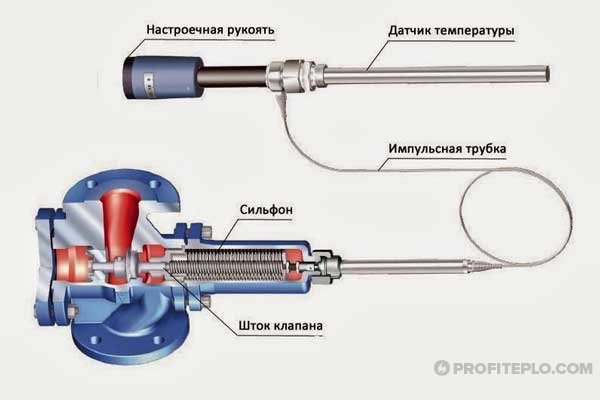

Regulator with temperature control sensor for balancing heating
As a result of a correctly performed balancing, the injection equipment begins to consume a minimum of electricity, and the consumption of thermal energy is carried out rationally.
Another problem that one has to face in the absence of special devices is the inability to determine the quality of the heat supply when it is in operation. Y-type balancing valves with measuring nipples have a self-diagnosis function of the system, which is as follows
:
- Determination of a malfunction while the heating system continues to work.
- Checking the technical condition and operating parameters of the equipment.
- Making decisions when troubleshooting.
Thus, errors are searched for and their quick elimination.
Electronic balancing system
Temperature balancing is a long and painstaking process. It is very difficult to accurately adjust complex heating systems in this way. It is much easier to use a smartphone with a dedicated mobile application, additional electronics and a circulating pump with a balancing function.
- a circulation pump with a corresponding function (in some cases, a removable pump head is installed on the existing pump, designed to balance the system);
- smartphone and special software;
- wireless communication module installed on the pump head.
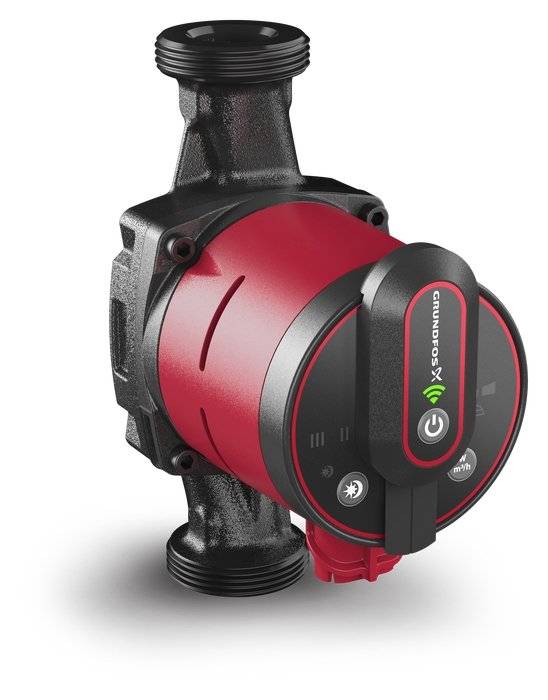

Electronic balancing of the system is carried out in four stages:
Preparatory - installing a special application on a mobile device and connecting the communication module to the pump. Entering data about the system (area of heated rooms, number of heating devices, coolant temperature, etc.), measuring the pressure and flow in each radiator or underfloor heating circuit (performed using a mobile application). The balancing of the system according to the data of the mobile application is carried out using balancing valves (valves). Dismantling the communication module and saving the balancing report generated by the mobile application.
Instead of a conclusion: correct balancing allows you to precisely adjust the operating parameters of the heating.
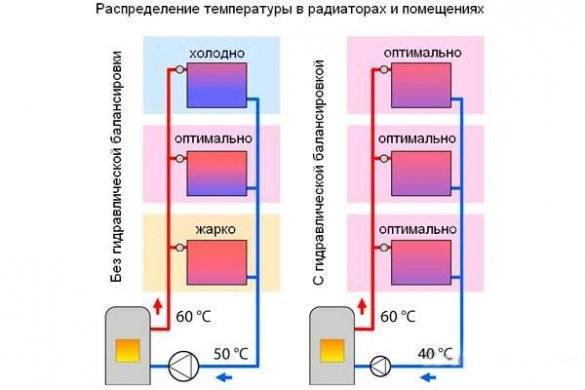

This significantly reduces the cost of operating the system and ensures the most comfortable temperature in all rooms.
What a homeowner needs to know about balancing heating systems
At first glance, it seems that there is nothing complicated in setting up. The temperature in the rooms can be adjusted without special measuring devices, independently, guided by subjective sensations: somewhere to make it warmer, and somewhere cooler. But often the result does not live up to expectations, since the ordinary user does not take into account the laws of hydraulics: an increase in the flow area of the balancing valve of one radiator will lead to a decrease in the flow rate on the other radiator
And here it is important to catch the same balance
“In an unbalanced heating system, to warm up all the rooms in the house, the circulation pump has to work with an increased load, which accelerates its wear and sometimes causes noise in the pipes. In such cases, you will have to forget about thermal comfort, as well as about savings, - says Maxim Nemkov, head of the installation department, which provides services for the design, installation and maintenance of engineering networks. - As practice shows, it is undesirable to arrange the heating system yourself - the probability of errors is too high. These include, for example, the selection of boilers and pumps with an unreasonable margin due to the unaccounted heat capacity of the rooms. Professionals do not allow such inaccuracies in their work. "
To minimize the risks, the homeowner must have the necessary information and constantly monitor the work of the installers. So, if the master assures that it is enough to design the heating system and configure the equipment in accordance with the calculations of the engineer, then it is better to contact another company. Real conditions always differ from theoretical ones: for example, the methods for calculating heat losses do not take into account the specific features of the building, which leads to deviations of the required coolant temperature from the design values. This is a common situation, but if left unattended, the system will not work correctly.
The balancing itself can be done in two ways. "Classic" implies the presence of a heating system project, according to which, by turning the balancing valves, the required design flow through each radiator is adjusted. But the presence of a project made without mistakes is not a frequent phenomenon now. And the real system may differ from the calculated one. If there is no project documentation, they resort to an "emergency" method. In such cases, an electronic thermometer is used to measure the temperature on any surface. With its help, the same outlet temperature of all heaters is set by means of balancing valves. “The general disadvantages of existing methods include the lack of a universal approach and high time costs. On average, balancing takes about one working day, it is carried out by at least two people ", - Anatoly Korsun, a professional installer, shares his experience. It is clear that such time expenditures are not profitable for a team of specialists, therefore, in an effort to work out as many objects as possible, they make ridiculous mistakes. As a result, the accuracy of balancing suffers, which negates the savings for which, in fact, everything was started.
Why balance the heating system in an MKD?
- Get rid of drafts due to overheating of the room
- Equalizing the temperature of the premises throughout the building will allow the automation to carry out better regulation.
- Complaints of tenants about underheating and stuffiness in apartments will become a thing of the past.
- Set on floors the same temperature value on all radiators.
JSC "Ural-Siberian Heat and Power Company", Tyumen
JSC "Tyumen Heat Networks", Tyumen
PJSC "SUENCO", Tobolsk
TPO "Teplo Tyumen", Tobolsk
MUP "Ishim heat networks", Ishim
Ishimgazstroy OJSC, Ishim
Required tools
If you ask a plumbing professional what device is needed for balancing, you will most likely hear about a thermal imager. It is used to determine the level of heating of all elements of the heating system. But the cost of such a "machine" is quite high. It makes no sense to buy a device for the sake of one operation. Basically, you can try renting it if you find it.But let's still try to get by with simpler and more affordable means.
For example, the following things will be enough for you:
- electronic contact thermometer. Needed to measure the heating temperature of heating equipment;
- screwdriver;
- a hex key, with which the balancing valve stem is rotated;
- paper and marker or pencil.
Ideally, you would need to stock up on the wiring diagram according to which the heating system was assembled. But often the project documentation is simply absent, because the assembly was carried out according to temporary sketches and practically "on the knee".
In this case, you will have to fill in the missing. You need to make at least a rough sketch of how all the elements of the heating system are located on paper. On this plan, it is necessary to indicate in what sequence the radiators are connected to the circuit and how far they are from the boiler room.
The second stage of preparation is flushing the sump located at the entrance to the heating boiler. Then preheat the heater to maximum power. As a rule, the temperature of the coolant should be approximately 80 degrees. This process does not depend on the weather outside - you still need to warm it up.
Balancing methods
the most common methods for balancing heating systems are:
- by the flow rate of the coolant,
- by the balance of temperatures.
By the flow rate of the coolant
This is a more accurate and efficient way. It will require a design of the pipeline system and an estimate of the flow rate in each of its segments. An approximate estimate calculation can be performed independently; for a more accurate one, the services of a heating engineer will be required. A balancing valve must be installed on each segment.
They work with the device in the following sequence:
- with partner valves, the entire heating system is divided into separate sections,
- measurements are taken through balancing valves in each module, the actual flow rate of the coolant in the area is determined,
- the data obtained is compared with the calculated consumption values for this segment,
- the valves are adjusted and the measurements are repeated.
If a PC with the installed program is available, then the task of preliminary calculation is simplified:
- measurement data is transferred to a PC, where the thermal and hydraulic model of the system is built,
- the program performs balancing, giving recommendations for the installation of each valve,
Further, the boiler power is set equal to the calculated value.
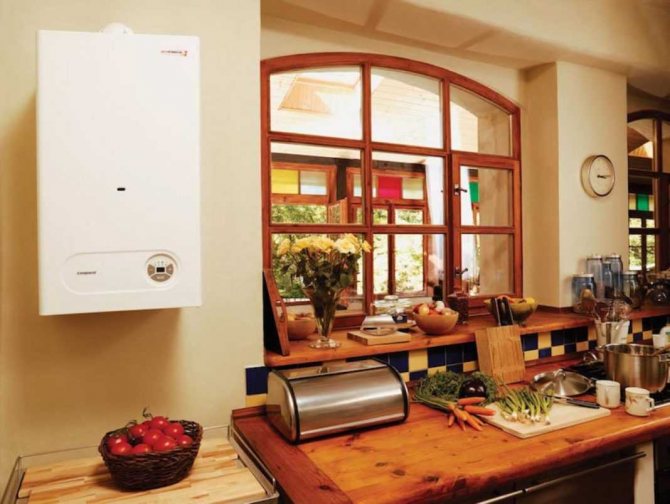

To balance the heating system, the boiler output is set equal to the calculated value
Balancing modules with a built-in flow meter are also offered on the market today, allowing coarse adjustment of the liquid flow rate without the use of an expensive measuring device. For non-heating systems in small buildings, this accuracy is quite sufficient.
After balancing is completed, each heat exchanger (or network segment) will receive and give into the room a strictly defined amount of heat energy, regardless of the distance between the radiator and the boiler, the floor and other factors. The advantages of a hydraulic balancing heating system are:
- high precision of system parameters setting,
- the ability to save up to 10% of energy resources in comparison with an unbalanced system,
- elimination of flow noises in the batteries and pipes closest to the boiler.
The disadvantages include:
- high cost of balancing valves and a universal measuring device,
- the need for a design hydraulic scheme with calculations of flow values in each segment.
For complex heating systems, and thus for balancing the heating system of a multi-storey building, this is the only way to increase the efficiency of the heating system.
By temperature
Often, the owner of a house, especially who recently acquired it, is faced with a situation where the house warms up unevenly, fuel is consumed inefficiently, and there is no documentation for the system. Thermal calculations are also missing.
The easiest way out in this case would be to adjust each radiator according to the surface temperature. Each heat exchanger will have to be fitted with a control valve with a thermostat. You will also need a pyrometer or electronic contact thermometer to measure the temperature of the battery.
Balancing work for a two-pipe heating system is carried out in the following sequence:
- on the heat exchanger farthest from the boiler, open the valve completely,
- passing along the pipe line from the far radiator to the near one, the valve of each is turned on the number of revolutions proportional to their number.
- measure the outlet temperature of each heat exchanger,
- moving from far to near, screw or unscrew the valve so that its temperature becomes equal to the previous one,
- between adjustment and measurement, you need to pause for 5-10 minutes to stabilize the coolant flow.
The advantages of temperature balancing are
- availability of control valves,
- ease of adjustment,
- no need for hydraulic circuit and precise calculations.
The disadvantages include:
- low accuracy of regulation,
- less energy efficiency
- dependence of the temperature regime of each radiator on the parameters of all the others,
This method is applicable for balancing the heating system with your own hands in small buildings.
Tying simple heating systems
A heating system can be called simple if it contains one straight circuit. A direct circuit means a line into which the coolant is supplied from the boiler without changing the initial temperature. Some radiator heating systems are simple. They can be one-pipe, two-pipe and mixed. The most practical type of simple radiator heating is a two-pipe system based on a supply and return line.
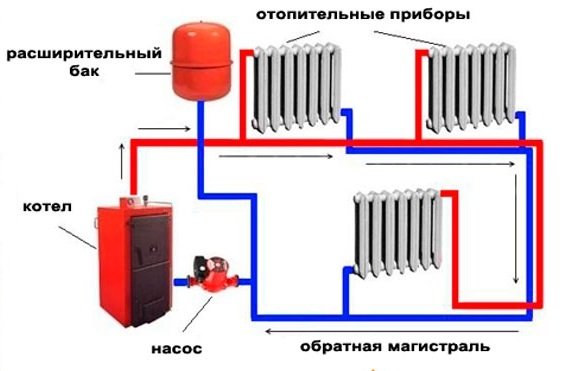

And if its balancing is done correctly, such a system will ensure uniform heating of radiators along the entire perimeter of the heating.
Let's consider the main elements of the system and their functions.


Expansion tank
Closed expansion tank - a tank equipped with a rubber membrane that divides the device into two parts (in the lower half there is a coolant, and in the upper half there is an inert gas). When the temperature in the heating system rises, part of the coolant enters it, thereby smoothing the pressure difference in the supply and return lines.
The tank can be installed in the immediate vicinity of the heating boiler. Additional shut-off valves (ball valve) installed in front of the tank entrance will make it easy to disconnect the tank from the system if it becomes necessary to repair or replace it.
Why balancing is needed
In the course of design calculations, the heat loss of each heated room is determined, and designed to compensate for their calculated thermal power. Based on it, an appropriate radiator or underfloor heating design is selected. In practice, an exact match cannot be achieved due to the influence of the following factors:
- the power of the radiators varies from model to model in steps, with a certain step,
- when choosing a tee wiring diagram, the radiators are connected in series, and the heat exchanger farthest from the boiler receives the coolant, which has given off part of its heat in the previous sections of the circuit,
- with equal pipe diameters, the radiators closest to the boiler will pass most of the liquid flow through themselves,
- open installation of heating pipes also contributes to heat loss.
An unbalanced heating system at home consumes energy irrationally. In order to keep warm in distant rooms, it is necessary to increase the boiler power and the pressure of the circulation pump. As a result, tropical heat sets in in the rooms next to the boiler room, but it is still cool at the periphery of the circuit.
This operating mode of the system leads to an unjustified increase in heating costs and to a reduction in the resource of the main devices.
To cope with this situation, the heating system must be hydraulically balanced.
In the course of balancing the heating system in a private house, the following goals are achieved:
- setting the optimal temperature regime in each room,
- optimization of the boiler operating mode and energy consumption,
- reduction of the noise level caused by the passage of large flows of coolant through the radiators located next to the boiler
Balancing is required for any heating system. It can be avoided only in the most modest one-story houses with 3-5 batteries, if pipes of the calculated diameter were used during installation.

